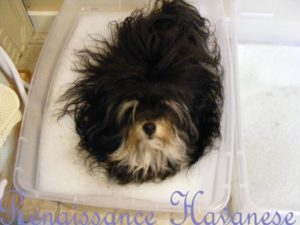PRIOR TO THE BATH remove tangles and mats.
This is the most important step, you need to remove tangles and mats before wetting them down. First spritz your dog with a detangler spray just enough to moisten the coat but not wet it. Working from the bottom undercoat to topcoat comb, concentrating on one area at a time. Your comb is your tangle detector, once you catch a tangle or mat, work with your dematting comb or brush to remove it. To see line combing demonstration, scroll down.
For short coats, It may be best to use a soft slicker brush, working sections at a time. Once you are done, you can run a comb through the hair from the skin out to check that there are no tangles. For the proper use of the slicker brush click HERE!
Sprinkle cornstarch on the tangle to help grip the hair and be gentle, the whole idea is to spare the hair. For mats, I find it easier to work out the hairs gently with a butter comb, taking my time. Sometimes no matter how hard we try, it needs more help and so I’ll use the small slicker. but easier to handle. This does all the work for you, pulling on the tight hairs to loosen them. You will lose some hair this way but you have a better chance of keeping the coat lovely then if you chop them out.
When you have to cut the mat out: sometimes despite our best efforts, we have to resort to cutting a mat out. Some mats are so tight to the skin that it causes discomfort to your dog. You should always invest in a good stainless steel scissor – don’t worry about the prices, your talking high quality, supplies that will last for years!
When cutting out a mat, go under it at the skin, make a hole in the mat and cut outward, never cut with the point facing your dogs skin for obvious reasons and please do not pull the skin away from the body, if you were to cut the skin, it would cause a nasty wound. Have someone assist in holding your dog until you all get used to the process. Once the comb can glide from the skin to the tips of the hair easily, the dog is ready for the bath.
I think the easiest way to get the coat clean in between shows or for dogs with short coats, is the bin bath technique as shown below!

Combing out the coat prior to bathing is the key to preserving the coat. You must remove tangles and mats before adding water, otherwise, the tangles get tighter making it more difficult to remove.
Indy has a very thick coat. It is easier to comb in sections.
 By lightly misting the coat with a water/conditioner mixture, I am able to prevent causing static, which breaks the coat. I avoid attempting to comb heavily soiled areas. Instead, I opt to wet this area with warm water and use a conditioner to carefully remove dried “dirt” by doing so, I can protect the hair and preserve coat.
By lightly misting the coat with a water/conditioner mixture, I am able to prevent causing static, which breaks the coat. I avoid attempting to comb heavily soiled areas. Instead, I opt to wet this area with warm water and use a conditioner to carefully remove dried “dirt” by doing so, I can protect the hair and preserve coat.
 This is a photo the uncombed side. She is groomed every 7 days. This makes it very easy for me to maintain her coat. She has less dead undercoat and tangles, she barely mats because I am committed to keeping her her coat clean and well maintained. It is a challenge but if you have the time and passion, you can do it.
This is a photo the uncombed side. She is groomed every 7 days. This makes it very easy for me to maintain her coat. She has less dead undercoat and tangles, she barely mats because I am committed to keeping her her coat clean and well maintained. It is a challenge but if you have the time and passion, you can do it.

Here is Indy on the finished side. This takes about 20 mins per side to comb.The comb should glide through the hair if you work on small sections and lightly mist the hair. Indy is not stacked properly but it was the best we could do!
Below, I have provided a short video showing you how I take tangle out of the coat.
Here is a short video demonstrating how to I remove tangles from the coat without damaging the hair:
Prepare the Bin Bath
I prefer to bathe and condition my dogs in a bin full of soap and water.The hair opens up in the water and dirt is released from the coat. My friend Ana Faust, likens it to washing a delicate piece of clothing. This is suitable for maintenance cleaning (in between shows) and I find that the conditioning bath is great for dry winter skin and coats. For traditional bathing in the sink, refer to Bathing the Havanese
 Simple clear plastic bins serve as the bathtubs. One contains a little shampoo, the other conditioner.
Simple clear plastic bins serve as the bathtubs. One contains a little shampoo, the other conditioner.
 All filled up, notice it’s not a bubble bath. I want enough shampoo to wash but not so much that It will be difficult to rinse off. I determined what was enough and too much through trial & error and certainly some dogs need more than others.
All filled up, notice it’s not a bubble bath. I want enough shampoo to wash but not so much that It will be difficult to rinse off. I determined what was enough and too much through trial & error and certainly some dogs need more than others.

If the water is comfortable, the dog will be comfortable.
With a first-timer, I put less water and always have an assistant (my girls) help me support the dog while I wash. A simple hand under the chin will help an unsure dog remain stable in the water. If a dog panics, I switch to cool, calm & collected mode and they follow.
Does she love it? Indy’s not talking but this is a weekly routine she has accepted with grace.
http://beccajcampbell.com/tag/expectation Here is a super short video but you’ll get the idea:
After drying off
For tips on drying and combing after the bath refer to the drying and combing again section available at this link: Bathing the Havanese
Supplies needed After Drying:
Nail clipper
safety scissors (rounded tips)
Antistatic spray (if needed)
Bingöl Trimming: Time to clip the nails, don’t forget the dewclaws. I know some breeders have these cut off of their few day old puppies. I opt my puppies out of this for various reasons, not relevant to grooming, so just ask and I shall share. The only problem I see is that it can be forgotten when trimming the nails. There is a link at the bottom of this page discussing dew claws with diagrams and purpose of this appendage.
Eyes: For the pet, you can use safety scissors to trim the hair around the eyes and the belly area*. Males tend to collect debris on their belly, from urine, you can trim the hair in this area to prevent that.
For the show dog: I will put the hair in a top knot.
Rear: For the pet, you can trim the rear using grooming scissors to keep debris from accumulating. Carefully trim the hair in a downward fashion, to avoid a choppy, uneven look.
For the show dog: minimal trimming is very specific, refer to your standard.
Feet: For the pet, trim the feet as well and clean up the pads, if you allow the hair to get too long on the pads, your dog loses traction and brings in a lot of dirt and mud, don’t overdo it, they should have hair between their toes but not over the pads.
For the show dog: this trimming is very specific and should not take away from the natural look of the dog, refer to your standard.
Take a good look at your dog, take a photograph and be proud of yourself! Give your dog a treat and praise him, end on a high note. Armed with the right information you can keep your Havanese dog lovely. Over time, it will become an easier and quicker process and before you know it, your pro!
This information is regarding the grooming of the Havanese, other breeds may require different techniques, shampoos or even specific brushes for their coat type. The Havanese has a double coat as well, so you would not groom a dog with a single coat in the same manner. Grooming practices are just as opinionated for breeders as feeding choices are, so the way I do it may be far from the way someone else does it. Keep an open mind when venturing into grooming. What’s most important is how well it works for you and your Havanese!
The most important information that I can give you, that I have learned from the professional show groomer is that a clean coat does not form mats. Brush in between a few times per week, misting the coat as you go and strive to bathe (at least) every two to three weeks, for the pet. More frequently for the show dog.

